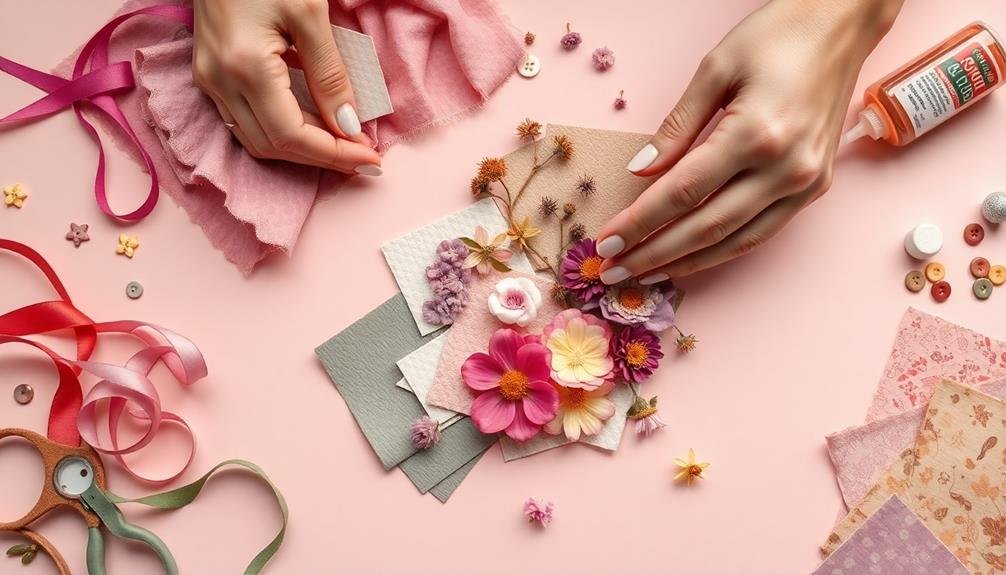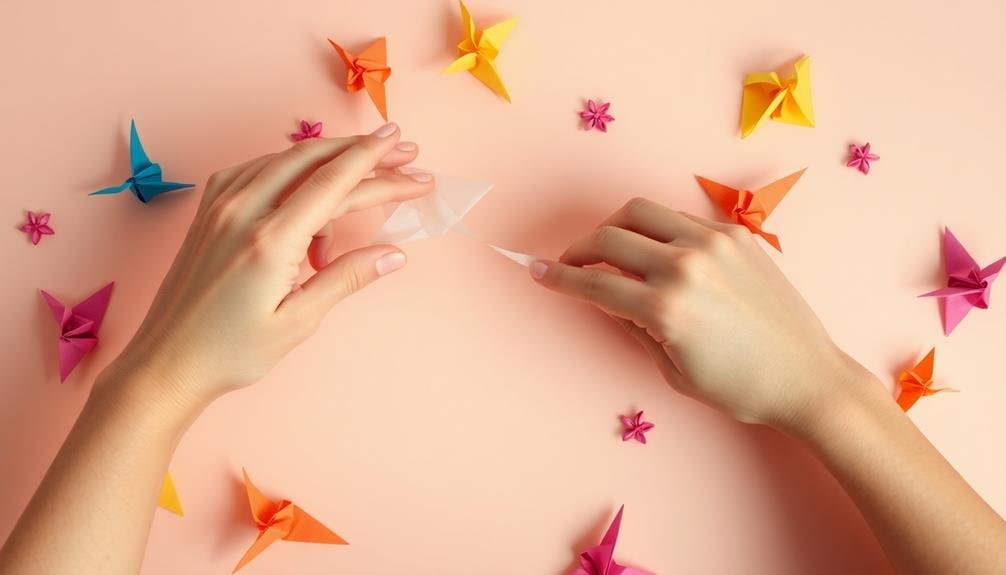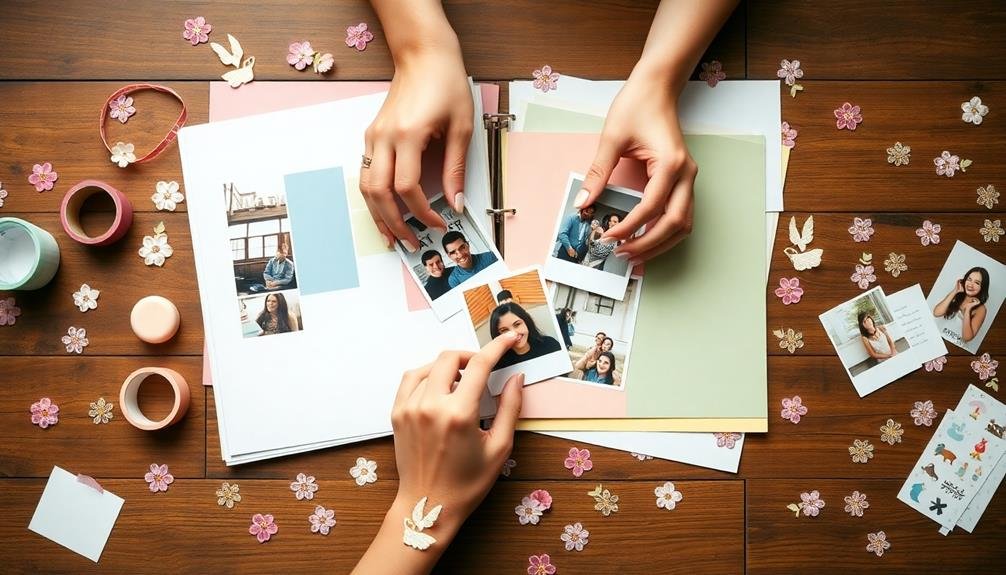Ease your anxiety with these three calming scrapbooking techniques. First, try sensory collage creation, using diverse textures to engage your senses and promote mindfulness. Next, combine gratitude journaling with scrapbooking, creating pages centered on things you're thankful for. Finally, explore meditative paper folding, using soothing colors and simple folds to reduce stress. Each technique offers a unique way to focus your mind, express creativity, and create tangible reminders of positive moments. These methods not only help you relax but also result in beautiful, personalized keepsakes. Discover how these techniques can transform your scrapbooking into a powerful tool for emotional wellbeing.
Sensory Collage Creation

Tranquility awaits in the art of sensory collage creation. This calming scrapbooking technique engages your senses, helping you focus on the present moment and ease anxiety.
Begin by gathering a variety of textured materials like fabric scraps, ribbon, sandpaper, and smooth pebbles. As you select each item, take time to feel its unique texture and consider how it makes you feel.
Next, choose a base for your collage, such as sturdy cardstock or a small canvas. Arrange your materials on the base, experimenting with different combinations and layouts. Don't worry about perfection; let your intuition guide you.
As you work, pay attention to the sounds of paper rustling and glue squelching. Once you're satisfied with your arrangement, start adhering the items to your base. Use different adhesives like glue sticks, liquid glue, or double-sided tape to add variety to the sensory experience.
Take deep breaths and focus on the pleasant scents of the materials and adhesives. When finished, run your hands over your creation, savoring the diverse textures you've brought together in harmony.
Gratitude Journaling Through Scrapbooking
While sensory collages engage your physical senses, gratitude journaling through scrapbooking taps into your emotional wellbeing. This technique combines the reflective practice of gratitude journaling with the creative elements of scrapbooking, offering a powerful tool for managing anxiety and fostering positivity.
To begin, select a dedicated scrapbook or journal for your gratitude entries. Each day, choose one thing you're thankful for and create a scrapbook page around it. Use photos, ticket stubs, or other mementos related to your chosen subject. Add decorative elements like washi tape, stickers, or hand-drawn illustrations to enhance the page's visual appeal.
As you craft each page, reflect deeply on why you're grateful for this particular person, experience, or thing. Write your thoughts directly on the page, incorporating them into the design. This process encourages mindfulness and helps shift your focus from anxious thoughts to positive experiences.
Over time, you'll build a tangible record of the good in your life. Whenever anxiety strikes, flip through your gratitude scrapbook to remind yourself of life's blessings and regain perspective.
Meditative Paper Folding Techniques

Have you ever considered the calming power of folding paper? Incorporating meditative paper folding techniques into your scrapbooking routine can greatly reduce stress and anxiety.
Start by selecting papers with soothing colors and textures that appeal to your senses. As you fold, focus on your breath and the sensations in your hands.
Begin with simple folds, like accordion pleats or basic origami shapes. These repetitive motions can help quiet your mind and promote mindfulness.
Try creating origami flowers or animals to embellish your scrapbook pages. As you become more comfortable, challenge yourself with intricate designs like modular origami or tessellations.
Don't worry about perfection; embrace the process and let go of expectations. The act of folding itself is therapeutic, regardless of the outcome.
Experiment with different paper types, from delicate washi to sturdy cardstock, to add variety to your creations. You can even incorporate your folded elements into 3D scrapbook layouts for added depth and interest.
Frequently Asked Questions
How Long Should I Spend on a Scrapbooking Session for Anxiety Relief?
You should spend as long as you feel comfortable. There's no set time limit for anxiety relief through scrapbooking. Start with 15-30 minutes and adjust based on your needs. It's about the process, not the duration.
Can Digital Scrapbooking Provide the Same Calming Benefits as Physical Scrapbooking?
Digital scrapbooking can offer similar calming benefits to physical scrapbooking. You'll still engage in creative expression and mindfulness. However, you might miss out on the tactile experience and sensory engagement that physical materials provide, which some find particularly soothing.
What Are the Best Scrapbooking Materials for Beginners on a Budget?
You'll want to start with essentials: a scrapbook album, cardstock, adhesive, and scissors. Don't forget pens and stickers for embellishments. Look for budget-friendly starter kits at craft stores or online. They'll have everything you need to begin.
How Can I Incorporate Aromatherapy Into My Scrapbooking Practice?
You can add essential oils to paper fibers or use scented stickers. Try incorporating dried herbs or flowers into your layouts. Don't forget scented inks or sprays. You'll create a multi-sensory experience that enhances your scrapbooking enjoyment.
Are There Any Scrapbooking Techniques Specifically Designed for Managing Panic Attacks?
You can use grounding techniques in scrapbooking to manage panic attacks. Try creating a "calm down" page with soothing colors, textures, and affirmations. Focus on mindful cutting and pasting to redirect your attention and slow your breathing.
In Summary
You've now explored three calming scrapbooking techniques to ease your anxiety. Whether you're creating sensory collages, journaling gratitude, or practicing meditative paper folding, you're engaging in mindful activities that can help reduce stress. Remember, scrapbooking isn't just about preserving memories; it's a therapeutic tool for managing emotions. As you continue to incorporate these techniques into your routine, you'll likely find yourself feeling more centered and relaxed. Don't hesitate to experiment and discover what works best for you.





Leave a Reply